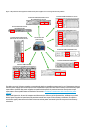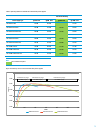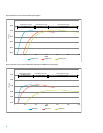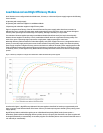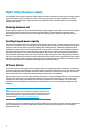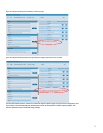
8
Right-sizing the power supply
The availability of HP CS power supplies in multiple capacities allows IT technicians to match the power supply capacity
to the actual load of a server configuration; that is, to select the right-size power supply. In addition to increased
efficiency, right-sizing the power supply also offers two immediate benefits: reducing hardware cost and avoiding
trapped power capacity.
Reducing hardware cost
Smaller capacity supplies cost less to purchase than larger capacity supplies. Nevertheless, IT infrastructure designers
often configure servers with larger-than-necessary supplies to allow for future expansion or upgrades. When
purchasing a significant number of servers, the savings from ordering only the capacities actually required can be
significant
Avoiding trapped power capacity
The amount of equipment that can be deployed in a given location, such as a rack, is in direct relation to the size of the
circuit that is provisioned. Often, more equipment can be deployed than nominally available through the use of power
capping, but that can also result in performance capping when used aggressively. Additionally, depending on local
regulations, large data centers may be required by law to size their power circuit (that is, their availability of power to
the location) based on the servers’ maximum power supply output rating or regulatory-plate rating. This method of
provisioning can quickly use up the data center power budget. Most servers, even fully configured and operating at
100% utilization, will typically require only 70% of the power supply capacity. Even if only 70% of power (at the most)
will ever be used, the data center will not be able to expand because the power circuit is trapped based on the required
method of provisioning. When using power supplies that more closely match the required power, the trapped capacity
can be reclaimed to power more equipment while staying in the same power budget.
HP Power Advisor
The HP Power Advisor utility removes much of the guesswork from estimating the power requirements of a particular
HP server configuration. Developed from actual measurement data collected from HP servers running under heavy load,
the Power Advisor allows the IT/facilities technician to build a virtual server system and accurately pre-calculate the
power needs of the server configuration without having to assemble and run the hardware.
Figure 4 shows a typical screen from a Power Advisor calculation for a ProLiant DL380p Gen8 server. The Power Advisor
allows the user to select precise configuration parameters such as processor type, memory size, and drives. As the
configuration is being made, the Power Advisor continuously calculates the “Current Wattage” and “Circuit Sizing”
requirements for the configuration. A Utilization slider control allows the user to set the projected degree of server
utilization.
Note
The Power Advisor allows users to avoid initial configuration mistakes such as
using an under-rated power supply. The Power Advisor should also be consulted
before reconfiguring a server. The HP Power Advisor can be downloaded from
the following URL:
http://www.hp.com/go/hppoweradvisor.
As shown in Figure 4A, if a redundant supply has not been added, the Power Advisor generates a message suggesting a
power supply addition. If the server configuration exceeds the capacity of the power supply, an error message is
displayed (Figure 4B).






